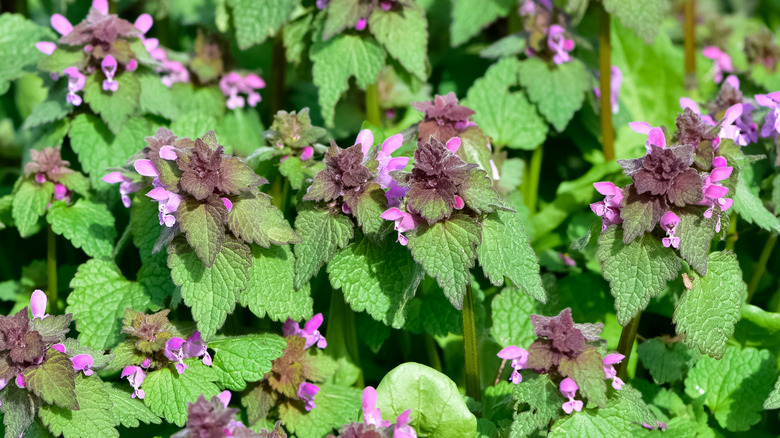Fill Your Yard With Stunning Purple Flowers By Planting This Ground Cover
If you want to try out a new type of ground cover that is more interesting and fun than regular old turf grass (and artificial grass isn't good for the ecosystem of your lawn, anyway), there are plenty of great alternatives out there that can serve as ground cover. While some plants, like blue mistflower, are best used as a ground cover in the garden to prevent weeds, there are other plants that also produce colorful blossoms and can be used as ground cover in both your lawn and garden. In this category, one of the most beautiful ground cover options is a plant with silvery white leaves and bright magenta flowers — the purple dragon lamium.
Although this flower is also known as spotted dead nettle, it is actually only called this because of its resemblance to the leaves of a traditional stinging nettle plant. Purple dragon lamium comes without the sting and is safe to touch (hence why "dead" is included in its name). Another great thing about this plant is that it grows quickly in a dense carpet which allows it to outcompete other plants like unwanted weeds. Purple dragon lamium also does well in shady or partially shady areas — where other things often don't grow. This beautiful ground cover plant can grow in zones three through eight, and is also a perennial that is evergreen in warmer climates and, in colder climates, may die off in winter, but still comes back year after year.
A few things to know before planting your purple dragon lamium
Before you pull up your turf grass and reseed your entire yard or garden with purple dragon lamium, it is important to know a few essential facts about this fragrant flower. While this fast-growing plant does well in shady and transitional areas, it doesn't do as well in full sun. If you do decide to try and grow purple dragon lamium in warm and sunny areas of your yard, then you will likely need to water it more frequently. However, you will need to be careful when watering because this plant can be easily damaged by rot if allowed to sit in poorly draining wet soil for too long.
Another thing to know about purple dragon lamium is that, as a member of the mint family, this plant is a voracious grower and often outcompetes other plants of a similar height. It's for this reason that this ground cover option is often grown alone or with other perennials that like shade and are taller and larger — like hostas and ferns. In fact, purple dragon lamium is such a voracious grower that it is even considered to be an invasive species in Kentucky. So, if you do decide to keep it in your yard, you will want to keep an eye on it and hand-pull or cut back any plants that are growing in undesirable locations. However, despite its downsides, the perennial and drought-resistant nature of this plant makes it a great option for areas of your yard that are too shady for grass to grow successfully. It also works as a weed preventative measure in your garden that doesn't require harsh chemicals, expensive mulch, or ugly landscaping fabric.

